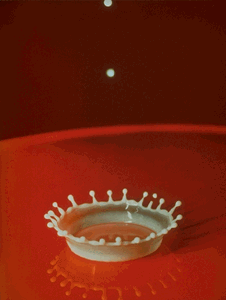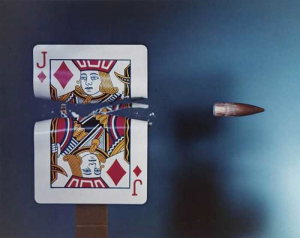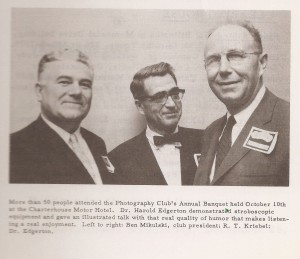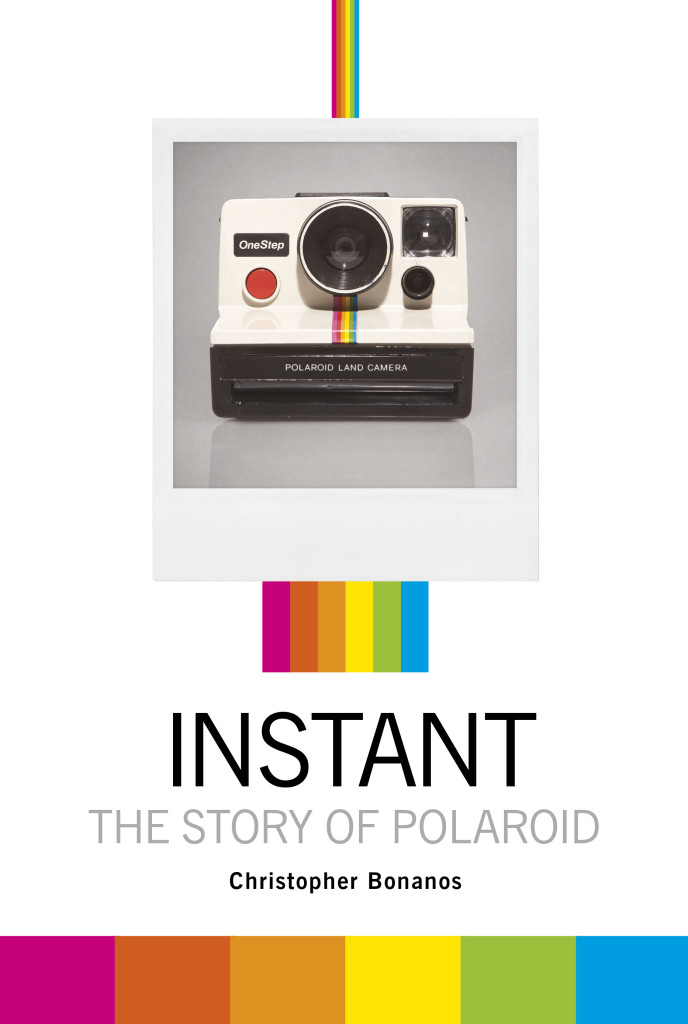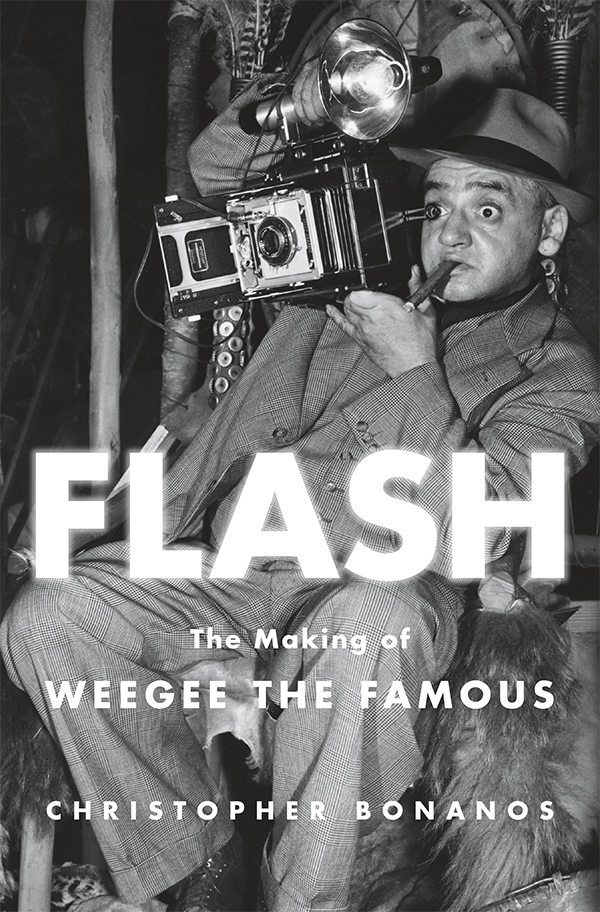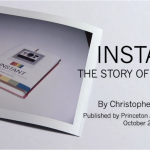The New York Times’s Lens blog, devoted to photography and film and other visual media, is today featuring the work of Jem Cohen, a moviemaker who has also been wielding a Polaroid camera in New York City for the past three decades. He specializes in distant, somewhat mysterious images of urban decay and similar scenes of loss, and works those little square frames extremely well. (He appears to shoot mostly Type 600 film.) Slideshow at the link above; he’s also got a film running at the Jewish Museum, on Fifth Avenue in New York, through March 25.
Most Polaroid freaks know about Dr. Florian Kaps, a.k.a. “Doc,” who is the guy more than any other who kept SX-70 and 600 film from disappearing forever. But there’s another Doc who figures in Polaroid’s history (and I don’t mean Dr. Land, whose only widely used nickname, as far as I know, was “Din”).
Dr. Harold Edgerton was an MIT professor, a celebrity in Cambridge and a minor celebrity elsewhere. (I remember first encountering him as the centerpiece of a PBS TV show, probably an episode of Nova, in the early 1980s.) Edgerton was the inventor of the electronic strobe that’s at the heart of every camera flash today, and although you may not know his name, you almost certainly know Doc Edgerton’s motion-freezing high-speed photos. The “Coronet” milk drop, from 1957, is his:
And so is the startled jack, reacting to a rifle bullet through his heart:
And he was also (you knew this was coming) an associate of Dr. Land’s, and a well-known figure around the Osborn Street labs. In the Polaroid Newsletter of October 29, 1963, he appears, in a note about a recent demonstration of his strobes that he did for Polaroid’s photography club. (There aren’t a lot of companies where in-house hobbyist groups get tutoring from legends.)
As for the other two guys who posed with him, I didn’t find anything in my research about Ben Mikulski, but I do know that Richard Kriebel was a major figure in Polaroid’s early history. He joined Land-Wheelwright Laboratories in 1935, and was the man who carried out Land’s lofty personnel policies, hiring women for significant jobs when other places did not, broadening benefits and perks when they could’ve gotten away with less. He stayed with Polaroid in various capacities till 1969, ending up the director of public relations, and died in 1990.
As for Edgerton, he too died in 1990 (a few weeks before Kriebel did, as it happens), and is a legend around MIT. You can read lots more about him at the Edgerton Digital Project site.
 Galley proofs are in! And so begins the hustle for media coverage. It’s weird to see this from the other side: I’m usually the magazine editor saying no. I hope it doesn’t turn me soft.
Galley proofs are in! And so begins the hustle for media coverage. It’s weird to see this from the other side: I’m usually the magazine editor saying no. I hope it doesn’t turn me soft.
Sharp-eyed readers—and there have to be a few of you, among the MILLIONS and MILLIONS of readers of this blog—may note a tweak up above. We have simplified the book’s subtitle. No more “A Cultural History of Polaroid,” which was a little tweedy for even me; henceforth it’s “The Story of Polaroid,” which is faster-sounding and more straightforward. Adjust your notes accordingly.
The only casualty is my rubber stamp. (When I shoot photos and give them away, I stamp them with the name and the title of the book, plus the URL of this site.) Gotta order a new one now.
One of Polaroid’s more memorable products of the seventies was the Face Place—the photo booth, with seat and curtain, many of us remember from trips to the mall. (Plenty of them still exist, though the analog ones are getting hard to find.)
A tech entrepreneur has taken that idea and compacted it into a little portable box called the Instaprint, with a twist: Any photo made via Instagram, hashtagged with the character string shown on the front panel, will immediately pop out of the printer as soon as it’s uploaded. Judging by the writeup on Instaprint’s Website, it uses the Zink technology and thermal printing head of Polaroid’s GL10 printer, a product that I rather like. Needless to say, the possibilities for (let’s say) corporate party events or nightclubs are significant, and the Instaprint people are trying to finance their project through Kickstarter. They say a donation of $399 guarantees you a product, and counts as a preorder. (Not sure where that leaves them in terms of actual product-development financing, but I’ll leave the details to their VC.)
Anyway, I approve. There are people who dislike Polaroid Zink printers because they’re not built around analog film; I say the point is to exchange photos with people on the spot, through whatever means works, and I have one of those little guys and enjoy using it. So good luck to the Instaprint people, and I look forward to trying out their product in a couple of years.
 My book now has its own Facebook page. It’s not like a personal page but is instead in the format that Facebook uses for businesses, which means you can’t Friend the book; you can only Like it. Now’s your chance!
My book now has its own Facebook page. It’s not like a personal page but is instead in the format that Facebook uses for businesses, which means you can’t Friend the book; you can only Like it. Now’s your chance!
In order to entice you over there, I’ve shared a short film, which is not posted on YouTube and thus can’t be embedded here. It’s titled Edwin Land: A Scrapbook, and it’s an 11-minute tribute made for Dr. Land’s memorial service in 1991, principally by the longtime Polaroid employees Sam Yanes, Bill Warriner, and Bill Field. (The 20×24 Studio put it up on its own Facebook page awhile back.)
What I find most compelling about the film is that its narration is made up entirely of clips spoken by Land himself, which are not that easy to come by. Although there are plenty of recordings of him in existence, most of them are locked up in the Polaroid archives at Harvard Business School, and that portion of the collection is years (possibly decades) away from being sorted, catalogued, and accessible. So until it’s all digitized and streamed, probably somewhere late in the 22nd century, we Polaroid freaks have to content ourselves mostly with scattered copies that have remained in private hands, like this one.
LEGALITIES
This site is not connected with or endorsed by Polaroid or PLR IP Holdings, owners of the Polaroid trademark.ON TWITTER
My TweetsBlogroll
- 'Insisting on the Impossible'
- Everything Reminds Me of You
- Flickr's Polaroid group
- Instant Options
- LandCameras.com
- Paul Giambarba: Analog Photography At Its Best
- Paul Giambarba: The Branding of Polaroid
- Polaroid
- Polaroid SF
- Rare Medium
- The Impossible Project
- The Land List
- The New55 Project
- Vintage Instant


